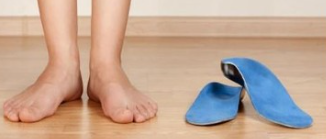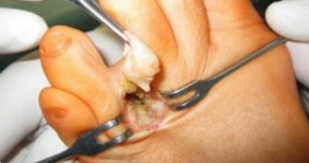Managing Morton’s Neuroma
September 18 2024
How a Podiatrist Can Help Relieve Foot Pain
🦶 Experiencing sharp pain or numbness in the ball of your foot? Morton’s neuroma could be the  cause, and a podiatrist can help with expert diagnosis and treatment options, from footwear changes to advanced care. 👣 #FootHealth #Podiatry #MortonsNeuroma #PainRelief #FFLC
cause, and a podiatrist can help with expert diagnosis and treatment options, from footwear changes to advanced care. 👣 #FootHealth #Podiatry #MortonsNeuroma #PainRelief #FFLC
Karan Malani
Kevin Lam, DPM, FACFAS
Morton’s neuroma is a painful condition affecting the foot, specifically the ball of the foot, usually between the third and fourth toes. It occurs when the tissue surrounding one of the nerves leading to the toes thickens, causing a sharp, burning pain, numbness, or a sensation of having a pebble in the shoe. This condition, also called intermetatarsal neuroma, can significantly impact a person’s mobility and quality of life, making early diagnosis and treatment essential. A podiatrist plays a critical role in identifying and managing Morton’s neuroma, offering both conservative and surgical treatment options tailored to the patient’s needs.
Causes and Symptoms of Morton’s Neuroma
Morton’s neuroma is often triggered by irritation, pressure, or injury to one of the nerves of the foot. Several factors can contribute to this, including:
Wearing tight, high-heeled, or narrow shoes: Footwear that squeezes the toes together can put pressure on the nerves, leading to inflammation and nerve thickening.

Repetitive activities: Running, jumping, or any other activity that involves repetitive pressure on the feet can aggravate the condition.
Foot abnormalities: People with flat feet, high arches, or hammertoes are more prone to developing Morton’s neuroma due to the abnormal mechanics of their feet.
Trauma: An injury to the foot can trigger nerve damage and subsequent neuroma development.
Diagnosis: A Podiatrist’s Approach
Podiatrists are uniquely equipped to diagnose and treat Morton’s neuroma because of their expertise in foot and ankle health. Diagnosis typically involves a detailed history and physical examination. The podiatrist will assess the patient’s foot structure, biomechanics, and the types of shoes worn regularly.
During the examination, the podiatrist may press on the affected area to check for pain or a clicking  sensation, called Mulder’s sign, which is a telltale sign of Morton’s neuroma. In some cases, imaging tests such as x-rays, ultrasound, or MRI scans may be recommended to rule out other causes of foot pain, such as stress fractures or arthritis.
sensation, called Mulder’s sign, which is a telltale sign of Morton’s neuroma. In some cases, imaging tests such as x-rays, ultrasound, or MRI scans may be recommended to rule out other causes of foot pain, such as stress fractures or arthritis.
Conservative Treatment Options
In most cases, podiatrists initially recommend conservative treatments to manage the symptoms of Morton’s neuroma.
These non-invasive approaches aim to reduce pressure on the affected nerve and alleviate pain, allowing the patient to return to daily activities without discomfort.
1. Footwear Modification: A podiatrist’s first line of defense against Morton’s neuroma often involves recommending changes in footwear. Switching to shoes with a wider toe box, lower heels, and proper arch support can relieve pressure on the nerve, reducing symptoms. Custom orthotic insoles may also be prescribed to provide additional support and correct any biomechanical issues contributing to the condition.
and proper arch support can relieve pressure on the nerve, reducing symptoms. Custom orthotic insoles may also be prescribed to provide additional support and correct any biomechanical issues contributing to the condition.
2. Padding and Taping: Padding the ball of the foot can help distribute weight more evenly and reduce the pressure on the neuroma. Podiatrists may also recommend taping the foot to alter the position of the metatarsals, alleviating pressure on the nerve.
3. Activity Modification: Reducing activities that exacerbate symptoms, such as running or standing for long periods, is another key recommendation. Podiatrists work with patients to develop an activity plan that minimizes strain on the foot while maintaining fitness.
4. Medications and Injections: Over-the-counter pain relievers and anti-inflammatory medications can help manage mild symptoms. For more severe pain, podiatrists may offer corticosteroid injections to reduce inflammation and provide relief. Some podiatrists may also suggest alcohol sclerosing injections, which shrink the neuroma by damaging the affecting nerve tissue.
Surgical Intervention
When conservative treatments fail to provide relief, podiatrists may consider surgical intervention. Surgery is typically reserved for patients whose symptoms persist despite trying non-invasive options for several months. The two main surgical approaches for Morton’s neuroma are:
1. Decompression Surgery: in this procedure, the podiatrist relieves pressure on the nerve by cutting nearby structures, such as ligaments, that are causing compression. This minimally invasive approach can alleviate symptoms without removing the nerve.
2. Nerve Removal (Neurectomy): For more severe cases, the podiatrist may remove the affected nerve altogether. This procedure can provide long-lasting relief, though it may result in permanent numbness in the toes. Podiatrists carefully evaluate each case to determine whether this approach is appropriate for the patient.
numbness in the toes. Podiatrists carefully evaluate each case to determine whether this approach is appropriate for the patient.
Post-operative care is crucial to ensure successful recovery, and podiatrists guide patients through the rehabilitation process. They provide advice on wound care, weight-bearing restrictions, and physical therapy exercises to regain strength and mobility in the foot.
The Podiatrist’s Expertise
Podiatrists are not only experts in the diagnosis and treatment of Morton’s neuroma but also in patient education and prevention strategies. They help patients understand the importance of early intervention and proactive foot care to prevent the condition from worsening.
This may include advice on proper footwear, maintaining a healthy weight to reduce pressure on the feet, and avoiding repetitive stress activities.
For individuals dealing with foot pain, especially in the ball of the foot, seeing a podiatrist early can make a significant difference in outcomes. Podiatrists offer a range of treatment options tailored to the severity of the condition and the patient’s lifestyle, helping them return to pain-free living as quickly as possible.
Morton’s neuroma can be a debilitating condition, but with the right care from a podiatrist, patients can find relief through both conservative and surgical treatments. Podiatrists play a vital role in diagnosing the condition, offering expert advice on footwear, activity modification, and other preventive measures. Their comprehensive approach ensures that patients receive personalized care, addressing both the symptoms and underlying causes of the neuroma, improving foot health and quality of life.
If you are experiencing Morton’s Neuroma, contact Dr. Malani’s office at (239) 430-3668 (FOOT) or visit NaplesPodiatrist.com to schedule an examination.
Serving Southwest Florida Since 2005, Family Foot & Leg Center has 9 convenient locations throughout Collier, Lee, Charlotte, and Sarasota Counties. Offering pediatric to geriatric family care: Ingrown Toenails, Heel Pain, Bunions, Foot / Ankle Arthritis Pain, Plantar Fasciitis, Foot / Ankle Surgery, Custom Orthotics, and Diabetic Wound Care. In office X-rays, ultrasounds, and minor surgical suite exam rooms. Practice powered by EMR and advanced technologies. Home of the Lam Minimally Invasive No-Scar Bunion Surgery! Come Discover Why Patients Love Our 5-Star Foot & Ankle Care! Same Day Appointments! Easy Online Appointment Scheduling.

 Fax: (239) 692-9436
Fax: (239) 692-9436 Tel: 239-430-3668
Tel: 239-430-3668

